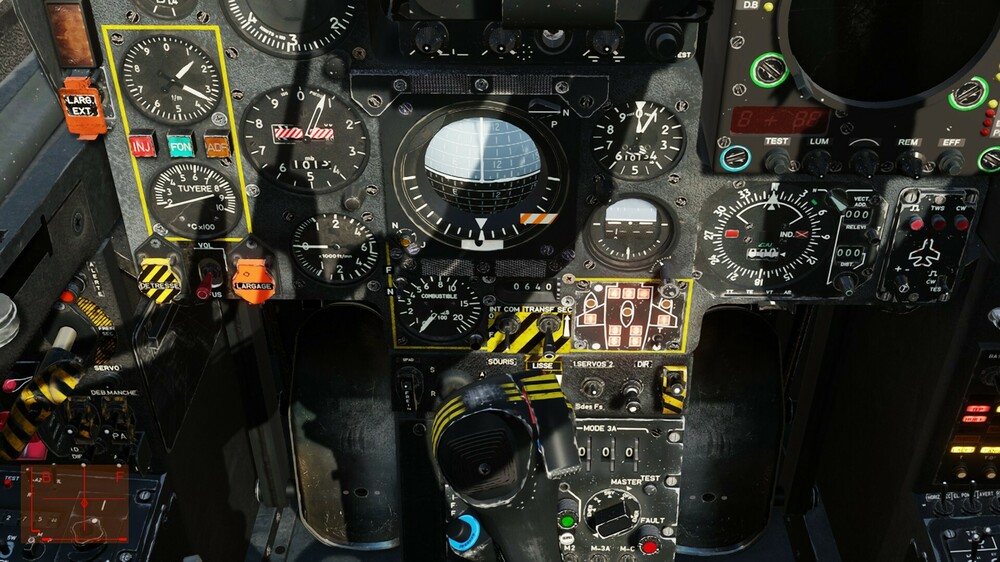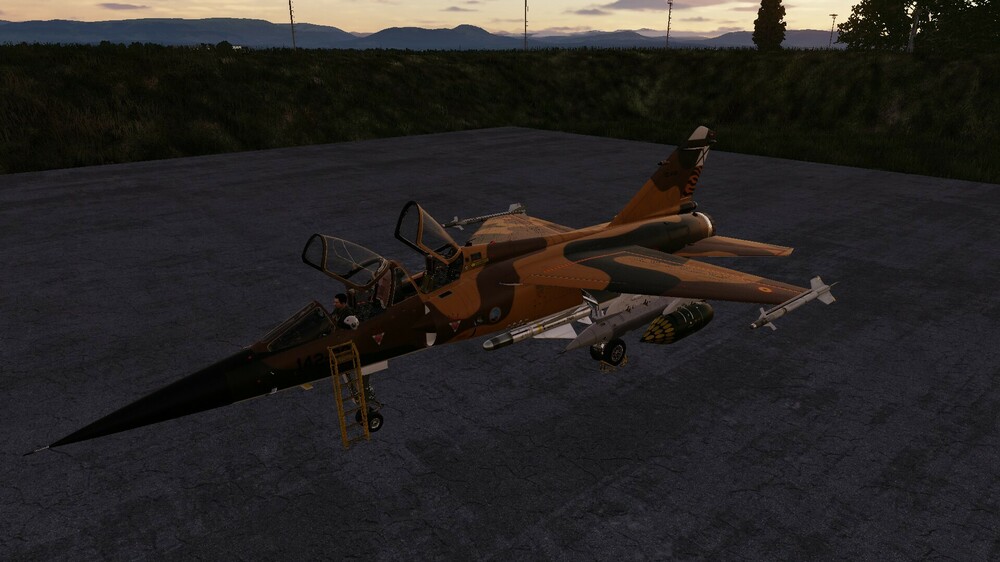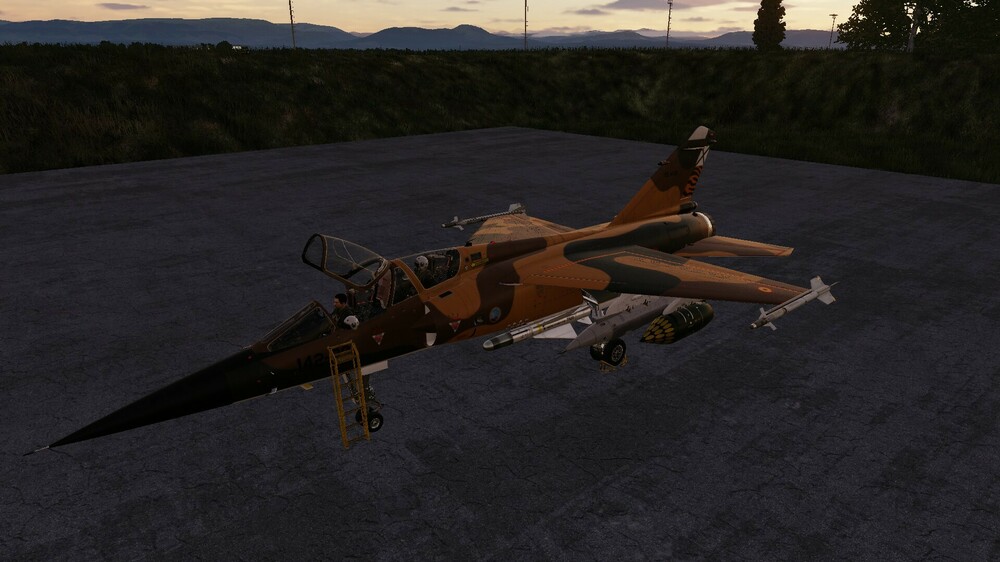-
Posts
2107 -
Joined
-
Last visited
Content Type
Profiles
Forums
Events
Everything posted by Bremspropeller
-
In theory it is. If you're engaged in a fast developing situation, possibly dehydrated because you've sat in readyness for an hour or two, things are a little different. Especially if the neighboring switch that completely feels the same does something entirely different and possibly decisive in the opponent's favor. Things are different, when you can die for real. I know what both the F-4E and the -21PFM fwd view looks like, as I've sat in the former and stuck my face into the cockpit of the latter. The Phantom's the winner here. Albeit not exactly by a mile. The good news for the early -21 pilot is that nobody yet had the bright idea of installing a make-up mirror which would rob you of your view into the turn at the benefit of not seeing anything behind you, twice. Again, in theory it is. If it was no biggie, we'd not spent dozens of millions on human factor research in man-machine interfaces. The F-4 also went through a couple of field-fiddles where they'd put rubber-extensions onto important switches, so you actually could find them when needed and without looking inside. Actual guncam footage proves the opposite.
-
Clearly it is. It's so ergonomic, they passed on giving the pilot a view anywhere ahead, so he can focus on that switch. Somewhere. The FL was modified to four pylons at some time. The PFM and FL are my favourite 21s, but that cockpit is not. The gunsight protrudes very far into the cabin and you literally have to look around it. Even the "no frills" F-13 sports-model isn't much better and it's sight is just there so the aircraft doesn't look incomplete. I mean, it looks impressive... ...but the gyro tumbles at ridiculously low g values. Looking through the Arab accounts - some of those pilots had been trained by the RAF or some RAF syllabus - it seems that the weapon-performance was one of the biggest detriments and many a kill opportunity was just lost because of poor performance and reliability or inferior weapon-capability. That's a pretty important point as well - mainly the VPAF was pretty pragmatic abot that approach. Sometimes they'd bait the fighters into throwing their bombs away, or going MiG-shopping some obvious bait-MiGs and leving the hapless bombers alone. Bernard Fipp (USN A-4 guy) wrote on one of those occurances in "Triple Sticks": The fighter dudes were good at football, but bad at chess...
-
The contemporary 21s had a different cockpit setup. Here's a PFM: Similar to the FL: That's because they had different circumstances. Soviet style intercepts worked well against the Groundhog-Day route-planning of the USAF. The wars in the middle east were a lot more dynamic and hence less favouring the MiGs.
-
That's because they all have large wings to carry their large-a$$ payload around. With said payload, they're not much of a turning-wonder either. LWFs are cool, because they can achieve a high kill-ratio against suppsoedly superior fighters, when using the right tactics. Back in the day the tech-gap between a MiG-21 and an F-4E with four Sparrows was mostly a paper-thing, as the F-4E (given no external IFF capability is at hand or Combat Tree mod is installed) has zero SA as to the nature of what it has locked. So you're down to a V-ID pass and all you tech advantage just went down the sink. When flying low level your radar is going to be a royal pain in the butt and locking somebody co-altitude or even look-down is going to be frustrating. Say goodbye to Mr "Sparrow in ya Face". The nature of the fights of those CW jets is much different to the AMRAAM-fest at 20NM that TV-screen operators are used to. What's often forgotten when discussing the MiGs is their sh1tty armament and their narrow engagement-zones (WEZ) during the time of those wars we're usually taking for benchmarking them against western jets. Don't forget about those silly engine blocker-doors and the louvers inside the strakes. Nice idea, but useless. I'd rather take the amount of fuel that could have been installed. I'm not sure the 21 is a better dogfighter. It's easier to to fly in some aspects, but it's cockpit ergonomics are dog sh1t. Having a HOTAS system where you could map important functions on a stick that doesn't exist in the real jet mitigates that issue quite a lot. Also, the F1 is a much better mission oriented aircraft. Just ask the iraqi pilots that had to take salt-pills flying the MiG. Just having a decent air conditioning system in the F1 made the aircraft a lot more effective.
-

options to remove ale-40 countermeasure dispensers
Bremspropeller replied to snocc_'s topic in Wish List
I'd like to second that -
Ackshually, that's an F-4S. Also note the AIM-9L. Here's the extended nose-strut of the FG.1 next to the extended strut of the F-4J* *The FG.1's nose strut is an extension of the hydraulically extendable strut of the vanilla Navy-variants. I'm not sure if the strut of the vanilla naval birds is longer than those of the AF models, but I think the AF models have the same strut-length, but theirs just isn't hydraulically extendable. I think the A-6 was first.
-
Combat flaps will retract automaticly when going beyond the speed-limit, manual flaps won't.
-
Saw your screenshot in the F1 section. Comtat Venaissin pack inbound?
-
The FAA (Fleet Air Arm) stopped operating the HMS Ark Royal (the Audacious Class boat)in 1978 and hence lost it's long range strike capability (Phantom FG.1 and Buccaneer S.2). This most probably opened the door to the eventual war. The Phantoms only came to the Falklands after the war. First on an improvised aluminium-plank runway-retrofit at Port Stanley, later on the actual fast jet capable airfield at Mount Pleasant.
-
The RAAF did, though. What-if history galore.
-

f1-EE - transfer/filling switch guard
Bremspropeller replied to bruddy32's topic in Bugs and Problems
Update: Seems to not be MP related. Might be a "hot start" vs "cold start" issue, though. -
It all depends on your frame of reference. If all you've flown so far was a Viper or Hornet, then you'll be in for a world of pain. If you have "prepared" and started flying contemporary fighters (F1, F-5, MiG-19 and MiG-21) then you'll have a much easier transition and you'll probably have an idea of what you're doing and where to focus on to get better. It's one of the grudges I have with all the BFM-tutorial videos showing Vipers with HMS and AIM-9Xs. The F-4 has a pretty good package for it's time, but your SA will nonetheless be eroded down to a radar, the RWR and good ole Eyeball Mk.1* - better get used to that quick. ___ *Geeks may throw in the TISEO and Jester Mk 2. That brings up a question: Will TISEO only be available on the later E?
-

f1-EE - transfer/filling switch guard
Bremspropeller replied to bruddy32's topic in Bugs and Problems
Just had this bug appear for the first time as well in MP. Seems to work fine in SP, though. -

F-4E Air to Air Weapons/Capabilities Discussion
Bremspropeller replied to Aussie_Mantis's topic in DCS: F-4E Phantom
Then there'd be two options: Get somebody else's jet (which you'd fly 98% of the time anyway) or skip to the next mission. What would really blow, though, is when the jet you're in decides it hasn't had enough aborts lately just before you're going in country. But that could happen with a normal randomized wear and tear as well. So maybe there'd be a "no mission aborts" option. I think a campaign system like this is viable, if it's done well enough. We'll see how the wear and tear system is going to progress -

F-4E Air to Air Weapons/Capabilities Discussion
Bremspropeller replied to Aussie_Mantis's topic in DCS: F-4E Phantom
I think you could introduce a squadron MX-board inside the dynamic campaign feature with "UP" and "DOWN" aircraft and with squawk-sheets attached to all aircraft, so you can see the individual writeups. I think this should be doable if the backend in the DCS framework is there. Certainly not an early access feature, but maybe a feature down the road. Imagine you'd be so deeply into dynamic campaigning that "69-7221" couldn't get it's engine-change performed last night because the transport with the new motor was stuck in Tan Son Nhut. Damned monsoon... It's alright, I get carried away sometimes -

F-4E Air to Air Weapons/Capabilities Discussion
Bremspropeller replied to Aussie_Mantis's topic in DCS: F-4E Phantom
Agree with everything you said, including the whole B/N or J/S dilemma. Except for the "your jet" part, though. There is no your jet. You fly with what's up and what you got. That includes aircraft with "down" radars for CAPs and escorts. Certainly with the Navy and Marines. The Air Force might have had a better spare-ratio, better equipped shops and logistical support. Now, if a dynamic campaign had that feature spread across the entire squadron, well, that would be really awesome! -

F-4E Air to Air Weapons/Capabilities Discussion
Bremspropeller replied to Aussie_Mantis's topic in DCS: F-4E Phantom
Doesn't really fit anywhere in between the A-A and A-G threads, but: Are we going to get the HPC (F-15 tank) and the original 600gal tank for the center-line, or just the HPC? -
One thing the F-4 crowd is gonna get really good at, is tanking. Think "Hornet" but with thirstier motors and more drag.
-
I feel the same. Stab Aug seems to have been tweaked.
-
Can't confirm. Did some maneuvering above and below M1.4 in blower and at MIL at both above and below 35k. No issues. Are you sure, you're at MIL and not below? The engine will spool down quite a bit and the restart takes some time. Don't go too fast. 300KIAS is plenty. The relight-envelope's on the left cockpit wall.
-

Hide the rear pilot when "Solo flight" is checked
Bremspropeller replied to VPS_SPIT's topic in Wish List
This would be very appreciated. Pylon on as standard, but deletable like on the other aircraft. -
Thanks you two!
-
Hi folks, just emptied the F1BEs tanks and the wheel (set on auto) still showed 640L when the engine flamed out. The Niveau lamp came on at about that amount above the normal level (500'ish). Haven't tried the other versions yet, but it might be related to the others as well.
-

2.9 F1EE / BE Landing gear lever logic wrong?
Bremspropeller replied to Goofy12's topic in Bugs and Problems
Okay, then it seems like I've also run into the rearm and reload bug described in another thread at the same time. -
Is the rear pilot disappearing with an open canpy known already? Offline, no matter which seat is taken. When you open the canopy (outside perspective), the rear ladder will just flash for a split second and then disapper - together with the rear pilot.






